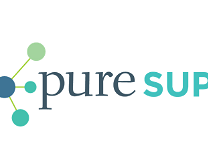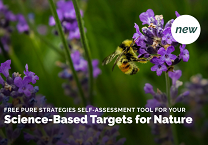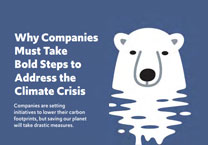Climate Strategies Step Into Scope 3: Tips for Science-Based Scope 3 Climate Targets
by Tim Greiner
27 February 2018
When Walmart announced its Project Gigaton goals in 2017, it raised the bar for corporate climate action. This ambitious commitment is aimed at reducing emissions from Scope 3 sources by one billion tons by 2030. While most companies have focused their climate strategies on their operations and energy use, Walmart set their greenhouse gas (GHG) emissions targets to align with climate science recommendations, which requires that the company reach into its value chain.
Walmart aims to reduce its absolute Scope 1 and 2 emissions by 18 percent by 2025. The retailer will also work to reduce CO2e, or carbon dioxide equivalent, emissions from upstream and downstream Scope 3 sources by one billion tons (a gigaton) between 2015 and 2030.
These goals were approved by the Science-Based Target Initiative (SBTi) and include the company’s direct and indirect Scope 1 and 2 emissions along with Scope 3 emissions from sources not owned or controlled by the company. More and more corporate leaders are looking to establish strategies aligned with SBTi, which requires Scope 3 emissions targets when Scope 3 emissions cover a significant portion of a company’s overall emissions - greater than 40 percent of total emissions. While most companies have experience with their Scope 1 and 2 emissions, Scope 3 is less familiar. However, corporate climate leaders that are ready to dig into this next frontier of climate strategy can start with a few manageable steps.
1: Identify Priorities
Once you determine that Scope 3 reductions will be part of your company’s target, begin by assessing the relevant GHG emissions hotspots. What should come from this effort are priorities focused on the areas of greatest impact and opportunity for improvement. Since Scope 3 covers emissions sources that are outside of a company’s direct operations and control, gathering and analyzing data from suppliers for such an assessment may seem like a daunting task. Rather than dive deeply into supplier data, it may be better to start with a screening level review. This assessment will help determine the boundaries for your efforts, such as which of the 15 SBTi categories to include in your roadmap.
Tools such as life cycle assessments (LCAs) and input/output tools are useful at this point, but a literature review can also pin point potential impact areas upstream and downstream. For example, when General Mills set out to establish a science-based target, an initial assessment revealed that nearly two-thirds of Scope 3 emissions occur in agriculture, ingredients, and packaging. With this information in hand, the company focused its strategy development to those areas with greatest reduction potential. For this screening-level analysis, companies do not need to commission their own studies, which can be costly and time intensive. For example, apparel companies sourcing large amounts of cotton can use industry-level LCAs and the Higg MSI to gain an understanding of agricultural emissions and emissions from upstream processing and downstream activities.
2. Develop your Baseline
With priority areas identified, the next step is developing a baseline of current climate performance to inform the target and action plan. Setting the baseline involves gathering detailed data on the Scope 3 categories in your scope. This could include gathering purchasing data of goods and services (SBTi Category 1), estimating downstream logistics impacts (SBTi Category 9), or approximating product use related emissions (SBTi Category 11). After an LCA that informed their priorities, Ben & Jerry’s focused their Scope 3 efforts on dairy and other ingredients, packaging, and franchise-related emissions. Pure Strategies helped the ice cream company develop their baseline by modeling the emissions from each of these parts of the value chain. Purchasing data from the company’s ERP system (e.g., ingredients, packaging) and energy and refrigeration data from franchisees were primary inputs used to calculate the company’s absolute and intensity baselines.
3. Build your Roadmap (Target and Plan)
Once you narrow the field with a screening level assessment and know the starting point (baseline), the next step is to complete a feasibility assessment and engage stakeholders to set the target and build the plan (though this can be done prior to the baseline assessment). This roadmap typically includes:
- A target for reduction and estimates of the reductions expected from the different priority areas;
- The business case for action, focused on the big drivers, opportunities, and investment needs;
- Identification of key players and partnerships needed to realize reduction goals.
In setting the target and establishing a plan, it is important to calibrate the forward-looking model to understand where reductions are feasible and what impacts business model changes, innovation, and low hanging fruit will have on future emissions. Working to align internal decision makers and getting external input is vital during the target setting stage. There are also a few key questions to answer:
- How ambitious a target does your company want to set?
- Will your target be quantitative such as an absolute reduction or qualitative such as pledging to get your value chain partners to set their own SBTs?
- Will you engage with all your suppliers or just the strategic suppliers where you have the greatest influence and best relationships?
To develop its roadmap for the Scope 3 strategy, Walmart set the bold target to reduce a gigaton of GHG emissions across its value chains and diverse portfolio of products. To work towards meeting this target, six “pillars” for action were created -- energy, agriculture, waste, packaging, deforestation, and product use. These were selected because they represent meaningful opportunities to reduce emissions across the retailer’s broad product categories where suppliers can contribute. Walmart launched the effort by reaching out to 250 of their top global suppliers and shortly thereafter expanded outreach efforts across its suppliers. Ben & Jerry’s roadmap prioritized its milk supply because of the significant contribution from dairy-related emissions. The company revamped its existing farm engagement program, Caring Dairy, to incentivize farmers to measure and reduce emissions from cows and farming practices. Their Scope 3 GHG reduction plan also includes collaboration with store franchisees to advance energy and refrigeration efficiency and engagement with the R&D team to drive carbon out of future products (i.e., ingredient and packaging choices). Involving internal and external stakeholders is critical in this process since companies can only achieve Scope 3 targets through collaboration with their partners in the value chain.
Investing in Scope 3 Strategies
With over 300 companies committed to taking science-based climate action, corporate climate leadership is entering a new era of investment and Scope 3 strategies are front and center. Given the magnitude of reductions needed to keep the planet to 2°C of warming, SBTs require a new level of coordination, alignment, and information management with your value chain. With a thoughtful and targeted Scope 3 strategy, a company can be well prepared to elevate its climate performance and lead climate action with its value chain partners.
This article originally appeared in Sustainable Brands.
Ben & Jerry’s and Walmart are clients of Pure Strategies.
Written by Tim Greiner
Tim Greiner, a Pure Strategies Co-founder and Managing Director, has pioneered approaches to building environmental and social integrity into products, brands, and businesses. He is also a co-founder of the Chemical Footprint Project and has guided sustainable chemicals management strategies for companies across diverse industries. His experience spans the spectrum from developing sustainability strategy, drafting sustainability goals, designing product sustainability programs, creating approaches to transform sustainable supply chains and facilitating a landscape level stakeholder process to improve climate and water quality outcomes.
Tim's recent projects include helping build a leading climate strategy for Ben & Jerry's, developing sustainability goals for King Arthur Baking, creating a corporate sustainability strategy for Lush, and developing a regenerative grazing standard for Timberland.












